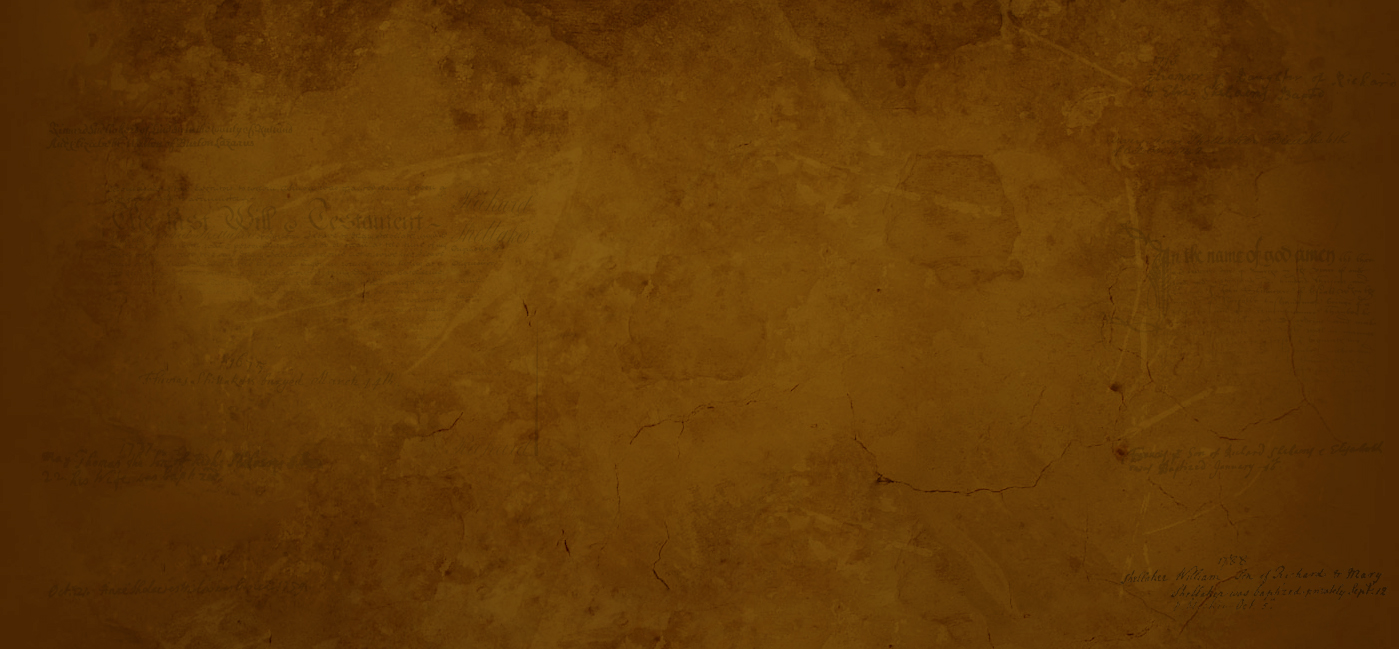

NELLIE AND JOHN BECOME PARENTS.
In the year following the end of The Great War (World War I) on Monday 24th February 1919, at the age of thirty-nine years, and after around eight years of marriage, Nellie gave birth to a baby girl. The girl was named Olive Mary. The name Olive was chosen as John Brown had a dislike for names that could be shorten or nicknames, possibly because he was known as ‘Johnny Brown’ as a boy. Olive’s second name of ‘Mary‘ was the name of Nellie’s mother. Olive’s birth certificate is below.
24th February 1919 – The Birth Certificate of Olive Brown – the Daughter of Nellie & John
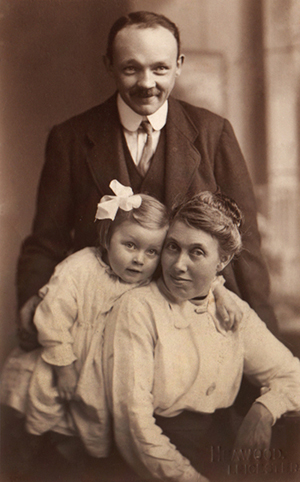 Olive is pictured on the right with her parents in October 1921 when she was aged 2 years and 8 months.
Olive is pictured on the right with her parents in October 1921 when she was aged 2 years and 8 months.
Postscript: In January 2000 I asked Olive to talk to me about living in The Nursery and her childhood in Billesdon in the 1920 & 1930’s. Her unique and contemporary account of living in that house is below.
The Nursery Cottage – the Ground Floor
As mentioned the Nursery was said to be around 500 years old and may well, at one time in its history, been two cottages. The roof was thatched but the thatch was now enclosed with a zinc covering. The house was L-shaped, with the main rooms in line with the road, (Back Street). The main entrance of the house was by the front door, which was accessible via the drive, that lead up to the Academy.
The front door opened into a long hall, containing a large table and a secrétaire (a writing desk with a glass fronted book cabinet on the top). To the left of the door was a window. Three doors lead from the hall to the other rooms on the ground floor. A door situated directly opposite the front door lead into a room known as ‘The Best Room’. This was a cosy room with two alcoves either side of the fireplace, which was to the left of the door. This room was furnished with two armchairs, a sofa and a piano. The room was below ground level and from the window, which was opposite the door and set into the thick walls of the house, enabled Nellie’s daughter Olive, to sit on the window sill and watch the strange sight of the legs walking by along Back Street. This room was chiefly used on Sundays, especially in the evening when Nellie’s brothers, together with their wives and families visited.
The second room on the ground floor, which was accessible both from the Best Room and the hall, was the living room. This room had a beamed ceiling and again had a window that looked out onto Back Street, although this window was higher than the one in the Best Room and not so big, consequently making the room rather dark, as was actually most of the house. The furniture in this room, which was a good size, included a dining table and four chairs, and two armchairs and a sofa.
The open fireplace was surrounded with tiles featuring a flowered design. In this room there also stood a Grandfather clock, made by ‘John Fox – Great Easton’ From this room a door lead to a space between the pantry of the left and the kitchen on the right. The pantry was large and shelved and in the area between the pantry and the kitchen stood a Welsh dresser.
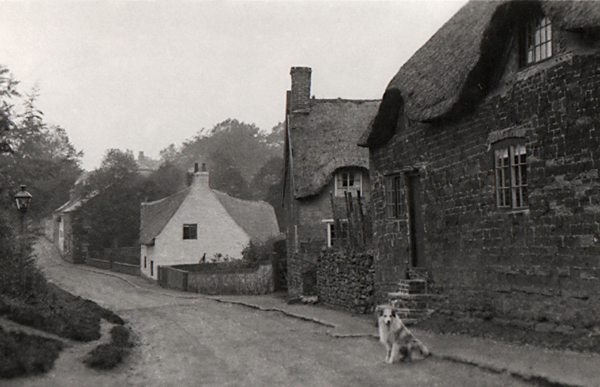 The kitchen was long, forming most of the ‘L’ that ran alongside Billesdon Brook. The floor of the kitchen was brick that needed to be scrubbed regularly. In the kitchen was the range (which was a large cooking stove in which the burners and oven needed to be kept continually hot). This range had an open fire with a boiler on one side and an oven on the other. This boiler was the only means by which to heat water, other than boiling kettles. A stone sink was equipped with a pump that brought water from a large tub in an adjoining shed.
The kitchen was long, forming most of the ‘L’ that ran alongside Billesdon Brook. The floor of the kitchen was brick that needed to be scrubbed regularly. In the kitchen was the range (which was a large cooking stove in which the burners and oven needed to be kept continually hot). This range had an open fire with a boiler on one side and an oven on the other. This boiler was the only means by which to heat water, other than boiling kettles. A stone sink was equipped with a pump that brought water from a large tub in an adjoining shed.
The kitchen was also used as a bathroom at times using a tin bath that had to be filled with hot water. Nellie’s daughter Olive recalls that it was lovely bathing in front of a coal fire and remembers that the bath water was used by two or three people before the bathtub was emptied!
Stairs from the kitchen lead to a large storeroom in which Nellie would store jars of preserved jam and bottled fruit. Nellie’s husband John had built wooden shelves in this storeroom to hold all of the containers.
Although each year Nellie would bottle more fruit and make more jam than the family needed, so the storeroom kept getting bigger. A window looked out from this storeroom onto the yard below.
The Nursery Cottage – the Upper Floor
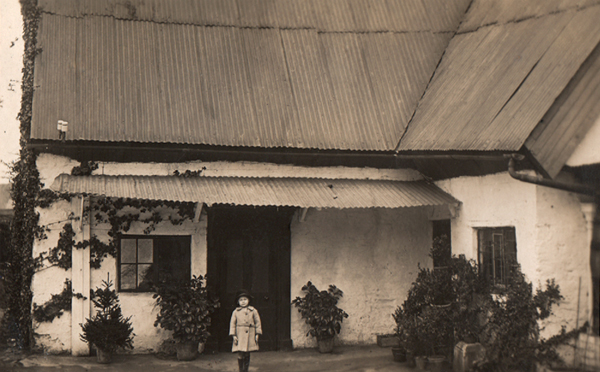 The remaining door in the hall led to the stairs by which the bedrooms were reached. These stairs were narrow and dark with a window at the top into the storeroom. Olive remembers that weird shapes were revealed was she walked up these stairs at night with a lighted candle. (The house had no electricity to provide any lighting). The lighting in the house was provided by candle, paraffin lamps and by a ‘modern’ Aladdin lamp through which air was pumped through fuel and provided light through a ‘mantle’. (A mantle was a fragile lacelike tube fixed round a gas jet which gave off an incandescent light).
The remaining door in the hall led to the stairs by which the bedrooms were reached. These stairs were narrow and dark with a window at the top into the storeroom. Olive remembers that weird shapes were revealed was she walked up these stairs at night with a lighted candle. (The house had no electricity to provide any lighting). The lighting in the house was provided by candle, paraffin lamps and by a ‘modern’ Aladdin lamp through which air was pumped through fuel and provided light through a ‘mantle’. (A mantle was a fragile lacelike tube fixed round a gas jet which gave off an incandescent light).
The stairs lead onto a long landing The first bedroom was large with a window overlooking the Back Street. This room contained a dressing table, a washstand, a wardrobe, a double bed and an octagonal sewing table (which sadly would not survived the dramatic events that would occur shortly). The room also had religious pictures on the wall, one of which, Olive remembers, was of ‘Jesus with the women by the well’.
A much smaller bedroom containing whitewood furniture was the bedroom of Nellie’s sister, Sarah Shellaker. This bedroom had a sloping ceiling, as had the adjoining bedroom and was entered by means of two or three steps. This bedroom was located at the end of the house with a view from the window up Back Street giving the best view from the house. Nellie’s daughter Olive can remember watching the building of the new ‘Widow’s Houses’ further up Back Street from this vantage point. The picture above right shows Nellie’s six year old daughter Olive standing in front of the Nursery in 1926
The Nursery Cottage – the outbuildings.
 On the ground floor a door from the kitchen, lead into the yard. On the driveway up to the Academy and adjoining the kitchen wall were two sheds, one of which had very large water butts standing upon a platform and at the end of the shed a small room containing the lavatory. Olive recalls that visits to the toilet, in the dark with only a lantern with a candle inside, especially for a nervous child as she was, were very creepy.
On the ground floor a door from the kitchen, lead into the yard. On the driveway up to the Academy and adjoining the kitchen wall were two sheds, one of which had very large water butts standing upon a platform and at the end of the shed a small room containing the lavatory. Olive recalls that visits to the toilet, in the dark with only a lantern with a candle inside, especially for a nervous child as she was, were very creepy.
The next shed in the yard was open like the first and contained a pump that supplied the family’s drinking water. Adjoining this shed was a brick building that was originally a stable but was used as a garage, as around the time of the birth of Olive, John Brown became the owner of a car. Olive believes that this first car was a Ford Van. It was their first car and was only the third in Billesdon, with Dr. Williams and Mr Woodcock, a local farmer, being the other two owners of motor vehicles.
As mentioned previously the yard led to the Academy, which at that time was divided into two and was owned by John Brown. To the right of the yard, steps lead into the Nursery gardens.
The Nursery Gardens.
 The Nursery itself was on a slope. One greenhouse, a relatively new one, was built just above the yard with a second greenhouse, containing a well or large water tank, adjoined a warehouse, which had previously been a cottage. In one room of the warehouse, a small coal-burning store was located to provide heat for the greenhouse. In another room, flowers and wreaths were stored as it was always cool. The flowers and wreaths were put together in the main room. Above the warehouse was a path which lead upwards, passed the potting shed, which was roofed but open-ended, to three more greenhouses.
The Nursery itself was on a slope. One greenhouse, a relatively new one, was built just above the yard with a second greenhouse, containing a well or large water tank, adjoined a warehouse, which had previously been a cottage. In one room of the warehouse, a small coal-burning store was located to provide heat for the greenhouse. In another room, flowers and wreaths were stored as it was always cool. The flowers and wreaths were put together in the main room. Above the warehouse was a path which lead upwards, passed the potting shed, which was roofed but open-ended, to three more greenhouses.
At the top of the garden, there was another greenhouse and a large tank of water fed by a spring from a nearby field, which was owned by Dr. Williams. Nearby was the main boiler house, which heated the three greenhouses. This was in a large hole with an entrance by means of a metal ladder. The boiler was large and was fed by coke, coal and general rubbish, with a large shovel. In the winter, the boilers were fed last thing at night, around 10 pm, and again early the next morning, this was in addition to adding fuels during the day.
Visitors come and go.
It was a very common occurrence for Nellie and John to have friends and family to stay with them, generally, when someone in the family had been sick. Nellie and John’s daughter Olive remembers on one occasion one of her father’s sisters was ill with anaemia, the main symptoms being tiredness and lethargy and for a cure she was required to eat raw liver! Olive’s cousins, Prim, Alice, Kath and Henry all spent time at the house. Cousin Henry was with the family for two to three years. John Brown sent him to learn bookkeeping at ‘Clarks College’ and then to be an apprentice at ‘Rowe Miles’, the family accountant. However, when his Uncle died (Mr Orton) he left Billesdon to help run the farm with his aunts.
Life in Billesdon
 At the time when Nellie’s daughter Olive was growing up she can remember two shops in the village; Smith’s family grocers and drapers shop on the Uppingham Road and Sharpe’s general provisions shop in the Market Place – picture right c.1912.
At the time when Nellie’s daughter Olive was growing up she can remember two shops in the village; Smith’s family grocers and drapers shop on the Uppingham Road and Sharpe’s general provisions shop in the Market Place – picture right c.1912.
These shops sold everything from paraffin to cheese to some items of clothing. Nellie would order goods from Smith’s that was delivered weekly.
Payne’s Bakers called three times a week in a van that was drawn by a horse that knew all the stops that his owner made during his deliveries.
Occasionally a businessman came from Leicester, Mr. Hemmings, who would take orders for garments, which were then made and delivered.
Milk was delivered daily to the door in large churns and was then measured out according to the amount that was required.
Food & Mealtimes
Nellie’s sister Sarah did all the usual cooking, dinners etc. She was a good cook, especially when making pastries (pies) and cakes. Sunday dinner would generally be a joint of meat with vegetables, which obviously, were mainly home grown. Pudding would follow, often a Bread & Butter Pudding containing raisins, accompanied by Egg Custard. They would often have suet puddings, like ‘Roly-Poly’, which were boiled in a cloth with a jam or treacle filling. A favourite pudding was ‘Matrimony pastry’ which had a filling of treacle and currants. Tea on a Sunday would consist of bread & butter, jam, tinned fruit, sometimes jelly and homemade cake.
On Monday or Tuesday the remainder of the Sunday joint would often be cooked as ‘Hash’, which was meat and vegetables cooked together with gravy. Many of relatives of Nellie and John were farmers, and on the occasions that a pig was killed, the ‘fry’* was often given to them, from which Sarah Shellaker would make very tasty faggots. [*Pig’s Fry consisted of the heart, liver, lungs and sweetbreads of a pig]
Sundays.
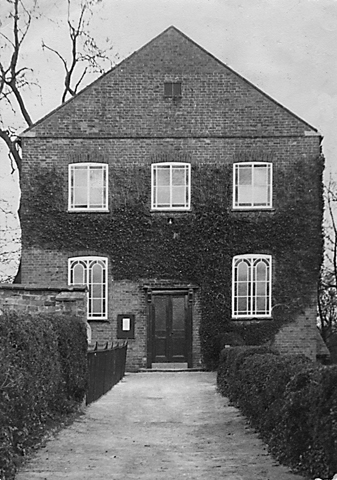 As the life of Nellie and her family centred on the Baptist chapel in Back Street, pictured on the right, Sundays were naturally always special days. On Sunday mornings Sunday School would commence at eleven, with Nellie’s daughter Olive in attendance and husband John was one of the Sunday School teachers. The other teacher was Sam Geary who was Nellie’s bother-in-law.
As the life of Nellie and her family centred on the Baptist chapel in Back Street, pictured on the right, Sundays were naturally always special days. On Sunday mornings Sunday School would commence at eleven, with Nellie’s daughter Olive in attendance and husband John was one of the Sunday School teachers. The other teacher was Sam Geary who was Nellie’s bother-in-law.
A second Sunday School lesson would start in the afternoon at half past two, followed by the afternoon service at three o’clock and an evening service at six-thirty. At the services, Nellie would record, in a book, some of the sermons preached, to remember the sermons she thought special.
Often the visiting preachers would be entertained for tea at the Nursery before the evening service. Many of these preachers becoming very good friend of the family. They also had a good influence upon Nellie & John’s young daughter Olive as she heard their difficulties and admired their faith. In addition to Sundays, services were also held on during the week.
Nellie’s husband John was the mainstay of the Billesdon Baptist Chapel, for many years he was the secretary, leader and Sunday school superintendent. Sunday was a busy day – after he had taken the morning Sunday school class he would return home, change clothes, stoke up all the greenhouse fires, then change clothes again for the afternoon Sunday school. After that another change back to his work clothes, stoke up the greenhouse fires and in the wintertime, it was also his responsibility to stoke up the chapel boilers to make sure the chapel was warm for evening service. Change clothes again for the evening chapel service and as there was no resident minister, it fell upon John Brown, as the chapel secretary, to try to arrange for ministers to take these services.
After the evening service there would often be time to visit one or two sick folk, then back home for family prayers before going to bed, ready to be up at six to recommence work in the Nursery – and it is called the ‘Day of Rest’!
Pets
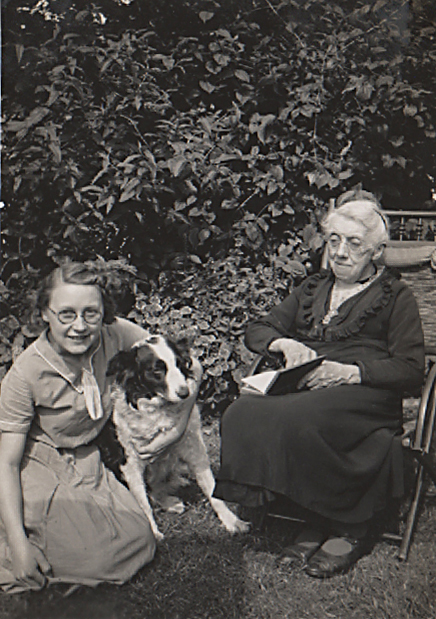 One of the major features around the Nursery was always cats! Stray animals seemed to know instinctively where Nellie lived and they were never turned away.The highest number of cats staying with Nellie and her family at any one time was six, but usually it was two or three. For a short time, the family had a lovely golden retriever, but in the company with another dog, a terrier, it was caught chasing sheep and had to be put down.
One of the major features around the Nursery was always cats! Stray animals seemed to know instinctively where Nellie lived and they were never turned away.The highest number of cats staying with Nellie and her family at any one time was six, but usually it was two or three. For a short time, the family had a lovely golden retriever, but in the company with another dog, a terrier, it was caught chasing sheep and had to be put down.
In addition to cats, a great number of other creatures lived at the cottage, mainly in the walls….At nights, large black beetles would emerge from the wattle and straw walls, and then would be squashed by John as he located them by lamplight.
Christmastime
At Christmas, it was usual for Nellie and her family to go to the home of her sister Emma, in Front Street, for the Christmas dinner. Emma’s husband, Sam Geary, would customarily receive a goose at that time of year from the Tailby family of Skeffington Hall, where he often undertook carpentry work. This gift would occasionally be a turkey, which was considered quite a treat in those days. After the Christmas dinner, the two families would sit around for a chat, or a sleep!
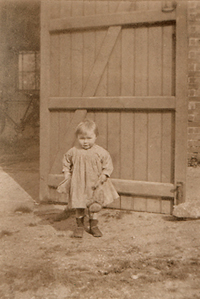 Nellie and John would be very busy in the weeks before Christmas, making Holly wreaths, but often they would join other members of the chapel congregation carol singing around the village on Christmas Eve. Nellie’s sister Emma would accompany the carol singers on a harmonium, which was placed upon a cart and pulled around the village.
Nellie and John would be very busy in the weeks before Christmas, making Holly wreaths, but often they would join other members of the chapel congregation carol singing around the village on Christmas Eve. Nellie’s sister Emma would accompany the carol singers on a harmonium, which was placed upon a cart and pulled around the village.
Nellie’s daughter, Olive, would greatly benefit from having many of her parent’s relatives living near, as she would receive many Christmas presents. In addition to presents from the family, she would also receive gifts from people with whom her father meet during his business. One of the more wealthy customers, Mr. Neale of Hallaton, gave Olive very nice presents. Olive can especially remember receiving books and she still has a copy of one of them, “The Golden Window” by Laura Richards, which consisted of forty-four parables for young and old. These were lovely short stories with quite a magical feel.
Olive would receive so many presents they were placed upon the table in the hall. Her parents often told her how lucky she was, as many of the village children would only receive a few gifts. Her favourite toy was her Teddy Bear, who shared her bed for many years. Olive is pictured on the left with that teddy bear.
One year she can also recollect receiving a large dolls pram, together with a large pot doll, however although she enjoyed playing with this doll, it did not hold any special affection in her memory. Olive had to take care of all her toys.
She loved reading and would greatly enjoy receiving a book for good attendance during the year, at the chapel Sunday school party, which was held annually. She also looked forward to receiving a Schoolgirl magazine from Leicester, brought by her cousin Henry during the time he stayed with the Browns.
Holidays
At holiday time, a large number of people were packed in one of John Brown’s many different cars and the family would travel to the sea for a summer outing. Olive can recall one journey to Hunstanton on the east coast, which consisted of herself, her parents Nellie & John, and also Annie Geary, Len Bates, Henry Orton and Sarah Shellaker – Seven people in total!
On another occasion a trip to Great Yarmouth, again with around seven people, turned into a nightmare as fumes from the vehicle got into the back of the van, and various people who were sitting upon a sofa in the back of the van, became rather ill.
OLIVE’S SCHOOL DAYS
Around the year 1924, Nellie took her daughter, now aged five, to school. After Olive had been a school a few weeks Nellie allowed her to walk to school alone, or on occasions, with friends. Olive went to the same National School that her mother had attended, which was located at the top of Gaulby Road. In the school there were two rooms, ‘The Little Room’ in which Miss Townsend taught the children aged between five and eight years old and ‘The Big Room’ where Mr. Fisher the Headmaster would teach the older children until they left school at the age of fourteen. When they reached the age of eleven the pupils would sit the “11 plus” examination. The year Olive sat the “11 plus”, five out the seven children passed the examination but only three went on to Grammar School due to the cost. Olive’s parents did not send her to Grammar School as it would have meant a lot of travelling on buses, so Olive left school at the age of fourteen years old in the year 1933.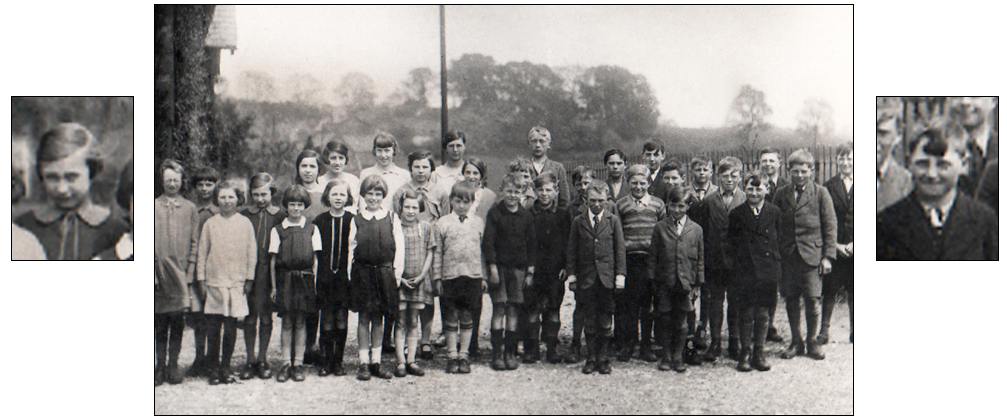 The picture above of a Billesdon school group, taken in 1930, shows ten or eleven year old Olive Brown – the girl fourth from the left. Also featured in this school group is a local boy, Kenneth Swift, who is standing fourth from the right.
The picture above of a Billesdon school group, taken in 1930, shows ten or eleven year old Olive Brown – the girl fourth from the left. Also featured in this school group is a local boy, Kenneth Swift, who is standing fourth from the right.
A DEATH, ANOTHER MARRIAGE, AND A NIECE.
During the time Olive was at school, her aunt, Mary Louisa Shellaker, the wife of Nellie’s brother William dies. She died on 24th February 1926. The following year William Shellaker marries for a second time. His new bride is Annie Maria Townsend, who he marries on 1st June 1927. William Shellaker was sixty-four years old on the occasion of his second marriage. Two years later William’s his new wife gave birth to a daughter, Mary, on 14th June 1929. William was sixty-six at this time. (William & Annie Shellaker would have a second daughter, Ann Shellaker, in December 1934 by which time William had reached the age of seventy-one).
Next Page: FIRE!